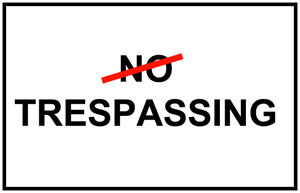Please note that the information on this website regarding photographers' rights and UK law must not be regarded as authoritative. It is written in general terms with a view to increasing general everyday understanding. However it is neither intended to provide authoritative advice nor to be used as guidance in specific cases. Anyone seeking authoritative advice regarding such matters, or anyone involved in a particular legal case, must seek the advice of a suitably qualified solicitor.
When on public property a photographer is, with few exceptions, free to photograph whatever he or she wishes. Public property includes public roads, footpaths, rights of way and the area between high tide and low tide on a beach - if not entire beach areas. In general, no one has the right of privacy of themselves or their property when photographed from public places. Consequently, private land and property owners (or tenants) do not normally have a right to prevent a photographer from taking photographs of their property from a public place such as a footpath or right of way.
 The situation is quite different for a photographer on private property, where land or property owners are free to impose whatever rules they wish. Examples of this may be encountered at stately homes, National Trust properties, museums, art galleries, concert venues, shopping centres etc. There is no general restriction on taking photographs while on private property as long as the photographer has permission from the owner to do so, but a photographer must observe any local rules imposed by the owner. If an owner allows access to private property only on the understanding that no photography is permitted, a photographer who then takes photographs commits a trespass and may be asked to leave.
The situation is quite different for a photographer on private property, where land or property owners are free to impose whatever rules they wish. Examples of this may be encountered at stately homes, National Trust properties, museums, art galleries, concert venues, shopping centres etc. There is no general restriction on taking photographs while on private property as long as the photographer has permission from the owner to do so, but a photographer must observe any local rules imposed by the owner. If an owner allows access to private property only on the understanding that no photography is permitted, a photographer who then takes photographs commits a trespass and may be asked to leave.
Trespass is not a criminal offence, and a photographer is unlikely to be arrested for a simple single instance of trespass. However, an owner of private property can take action through the civil courts and might be awarded damages even in cases where no physical damage occurred. Exceptions to this include trespassing on railways or MOD land. In such cases, prosecution is more likely.
Another interpretation of trespass relates to trespass to a person. This is essentially where the actions of a photographer force someone in to a situation where their photograph may be taken, perhaps by deliberately blocking the subject's way. One might well wonder why every member of the paparazzi has not been in court! A further offence, known as aggravated trespass, is committed when two or more people trespass with the purpose of disrupting a lawful activity. This provision was introduced to prevent illegal raves but might also be used against photographers. In such instances arrest is more likely.






